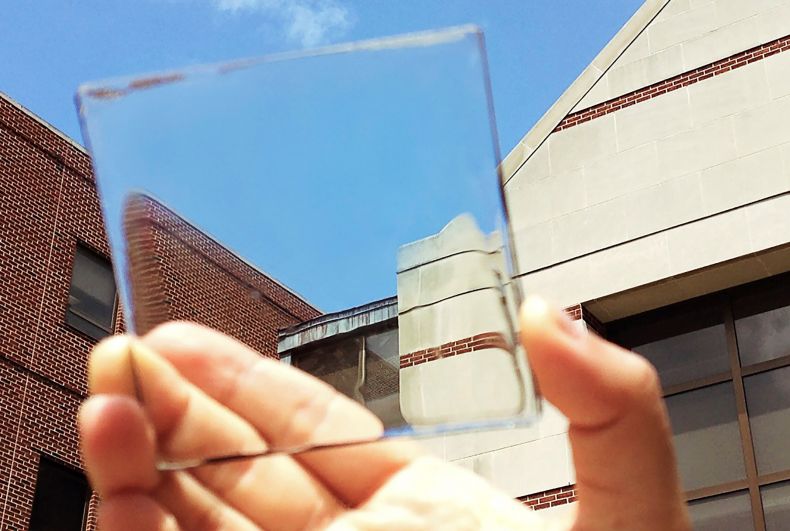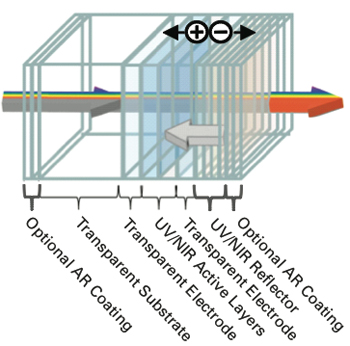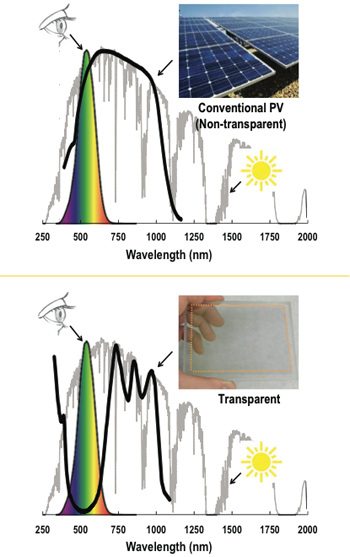TR/EN Yarının pencereleri nasıl elektrik üretecek?
 •
by
•
by M.Y.S.T.E.R.I.A
TR/Görünmez Güneş Panellerine Giden Yolda

Paris iklim anlaşmasından beş yıl sonra, tüm gözler dünyanın karbonsuz bir geleceğe giden yolda ilerlemesine odaklanıyor.
Bu hedefin önemli bir kısmı, fosil yakıtlardan güneş, su, rüzgar ve dalga enerjisi gibi yenilenebilir kaynaklara enerji geçişini içermektedir. Bunlar arasında güneş enerjisi, dünyadaki en güvenilir ve bol enerji kaynağı olarak bilim camiasında her zaman en yüksek umudu beslemiştir.
Son yıllarda, güneş pilleri daha ucuz, daha verimli ve çevre dostu hale geldi. Bununla birlikte, mevcut güneş pilleri opak olma eğilimindedir, bu da onların daha geniş kullanımlarını ve günlük malzemelere entegrasyonunu engelleyerek, çatılarda ve uzaktaki güneş enerjisi çiftliklerinde kullanılacak şekilde sınırlamıştır.
Peki ya yeni nesil güneş panelleri pencerelere, binalara ve hatta cep telefonu ekranlarına entegre edilebilirse?
Kore Incheon Ulusal Üniversitesi Elektrik Mühendisliği Bölümünden Profesör Joondong Kim bu konuda epey umutlu.
Journal of Power Sources'de yayınlanan yakın tarihli bir çalışmada, tamamen şeffaf bir güneş pili tasarımı dikkat çekiyor. Prof. Kim, "Şeffaf fotovoltaik hücrelerin benzersiz özelliklerinin insan teknolojisinde çeşitli uygulamaları olabilir" diyor.
Şeffaf güneş pilleri fikri iyi biliniyor, ancak bilim adamlarının bu fikri uygulamaya dönüştürebildikleri bu yeni uygulama çok önemli bir yeni bulgudur.
Şu anda, güneş pilini opak yapan malzemeler, ışığı yakalamaktan ve onu elektrik akımına çevirmekten sorumlu olan yarı iletken tabakalardır. Bu nedenle, Prof. Kim ve meslektaşları, istenen özellikleri nedeniyle önceki araştırmacılar tarafından belirlenen iki potansiyel yarı iletken malzemeye baktılar.

İlki, güneş pilleri yapmak için zaten yaygın olarak kullanılan, iyi bilinen bir yarı iletken olan titanyum dioksittir (TiO 2 ). Mükemmel elektriksel özelliklerinin yanı sıra, TiO 2 aynı zamanda çevre dostu ve toksik olmayan bir malzemedir. Bu malzeme UV ışığını (ışık spektrumunun çıplak gözle görülemeyen bir kısmı) emerken, görünür ışık aralığının çoğuna izin verir.
İkinci malzeme ise yüksek optik şeffaflığa sahip olduğu bilinen başka bir yarı iletken olan nikel oksittir (NiO). Nikel, yeryüzünde bol bulunan elementlerden biri olduğu ve oksidi düşük endüstriyel sıcaklıklarda kolayca üretilebildiği için NiO, çevre dostu hücreler yapmak için de harika bir malzemedir.
Araştırmacılar tarafından hazırlanan güneş pili, bir cam substrat ve bir metal oksit elektrottan oluşuyordu, bunların üzerine ince yarı iletken katmanları (önce TiO 2 , sonra NiO) ve diğeri gibi davranan son bir gümüş nanotel kaplaması bıraktılar. Hücredeki elektrot. Cihazın ışık emiciliği ve geçirgenliğinin yanı sıra güneş pili olarak etkinliğini değerlendirmek için birkaç test yaptılar.
Bulguları cesaret vericiydi; % 2,1'lik güç dönüştürme verimliliğiyle, hücrenin performansı, ışık spektrumunun yalnızca küçük bir bölümünü hedeflediği göz önüne alındığında oldukça iyiydi. Hücre ayrıca oldukça duyarlıydı ve düşük ışık koşullarında çalıştı. Dahası, görünür ışığın% 57'sinden fazlası hücrenin katmanlarından geçerek hücreye bu saydam görünümü kazandırdı.
Deneylerinin son bölümünde araştırmacılar, cihazlarının küçük bir motora güç sağlamak için nasıl kullanılabileceğini gösterdiler. Prof. Kim, "Bu yenilikçi güneş pili henüz başlangıç aşamasındayken, sonuçlarımız, hücrenin optik ve elektriksel özelliklerini optimize ederek şeffaf fotovoltaikler için daha fazla iyileştirmenin mümkün olduğunu güçlü bir şekilde göstermektedir" diyor.
Artık şeffaf bir güneş pilinin pratikliğini gösterdiklerine göre, yakın gelecekte verimliliğini daha da artırmayı umuyorlar. Sadece daha ileri araştırmalar, bunların gerçekten gerçek olup olmayacağını söyleyebilir, ancak tüm niyet ve amaçlar için, bu yeni teknoloji, temiz enerjinin geleceğine - gerçek anlamda - bir pencere açıyor.

Kaynak: Incheon Devlet Üniversitesi - Güney Kore
Incheon National University
EN/How tomorrow's windows will generate electricity?
On the road to invisible solar panels
Five years after the Paris climate agreement, all eyes are on the world's progress on the road to a carbon-free future. A crucial part of this goal involves the energy transition from fossil fuels to renewable sources, such as sun, water, wind and wave energy. Among those, solar energy has always held the highest hope in the scientific community, as the most reliable and abundant energy source on Earth. In recent decades, solar cells have become cheaper, more efficient, and environment friendly. However, current solar cells tend to be opaque, which prevents their wider use and integration into everyday materials, constrained to being lined up on roofs and in remote solar farms.
But what if next-generation solar panels could be integrated to windows, buildings, or even mobile phone screens? That is the hope of Professor Joondong Kim from the Department of Electrical Engineering at Incheon National University, Korea. In a recent study published in Journal of Power Sources, he and his colleagues detail their latest invention: a fully transparent solar cell. "The unique features of transparent photovoltaic cells could have various applications in human technology," says Prof. Kim.
The idea of transparent solar cells is well known, but this novel application where scientists have been able to translate this idea into practice is a crucial new finding. At present, the materials making the solar cell opaque are the semiconductor layers, those responsible for capturing light and translating it into an electrical current. Hence, Prof. Kim and his colleagues looked at two potential semiconductor materials, identified by previous researchers for their desirable properties.
The first is titanium dioxide (TiO2), a well-known semiconductor already widely used to make solar cells. On top of its excellent electrical properties, TiO2 is also an environment-friendly and non-toxic material. This material absorbs UV light (a part of the light spectrum invisible to the naked eye) while letting through most of the visible light range. The second material investigated to make this junction was nickel oxide (NiO), another semiconductor known to have high optical transparency. As nickel is one of the mist abundant elements on Earth, and its oxide can easily be manufactured at low industrial temperatures, NiO is also a great material to make eco-friendly cells.
The solar cell prepared by the researchers was composed of a glass substrate and a metal oxide electrode, on top of which they deposited thin layers of the semiconductors (TiO2 first, then NiO) and a final coating of silver nanowires, acting as the other electrode in the cell. They ran several tests to evaluate the device's absorbance and transmittance of light, as well as its effectiveness as a solar cell.
Their findings were encouraging; with a power conversion efficiency of 2.1%, the cell's performance was quite good, given that it targets only a small part of the light spectrum. The cell was also highly responsive and worked in low light conditions. Furthermore, more than 57% of visible light was transmitted through the cell's layers, giving the cell this transparent aspect. In the final part of their experiment, the researchers demonstrated how their device could be used to power a small motor. "While this innovative solar cell is still very much in its infancy, our results strongly suggest that further improvement is possible for transparent photovoltaics by optimizing the cell's optical and electrical properties," suggests Prof. Kim.
Now that they have demonstrated the practicality of a transparent solar cell, they hope to further improve its efficiency in the near future. Only further research can tell whether they will indeed become a reality, but for all intents and purposes, this new technology opens a -- quite literal -- window into the future of clean energy.
Source: Incheon National University


Comments
o7
Vote.
Apartmanların çatı katları daha değerli hale mi gelecek?
Çatı uygulamaları başladı reis zaten. 10 kWya kadar lisanssız işletmeye alabilirsiniz. 10kW normal bir ev için çok gelebilir. Fiyatlar düşüyor araştırıp bakmak lazımonla ilgili olarak da bir makale atacağım aklımda. Orta karar bir eve 3-5 kW yeter diyor işin uzmanı mühendis kardeşlerimiz. Bu gelen ise transparan fotovoltaik, bina camları, cam cepheler, telefon, tabletten tut araba, otobüs camlarına kadar her yere uygulanma imkanı var. Daha geniş bir alanda. o/
Elektrik paneli için link lazım
This is good job. O/
bu ıs olursaa evlerın elektrık ıhtıyacları kendı camlarından uretılırse..bızım camcı lar 😃 burnundan kıl aldırmaz.. keske daha ergonoımık sekılde hayatımıza gırse.. gayet guzewl bırsey... makalalerını takıp etmekteyım
o7
pencere camlarındaki piller ya patlarsa
cep telefonu pilleri gibi, bu risk yok mu sence?
Very cool.